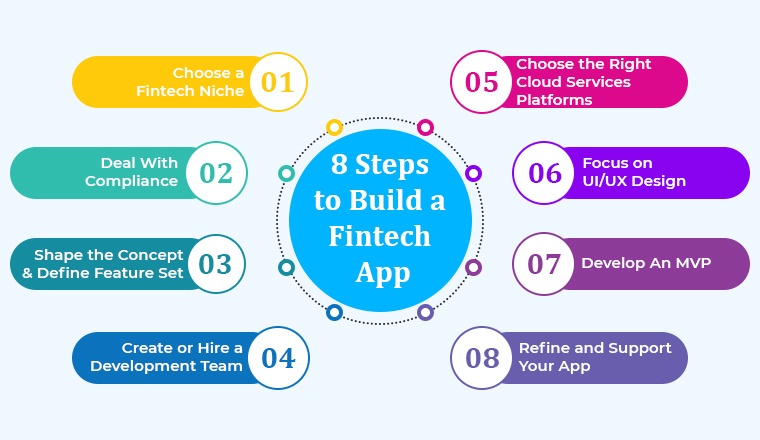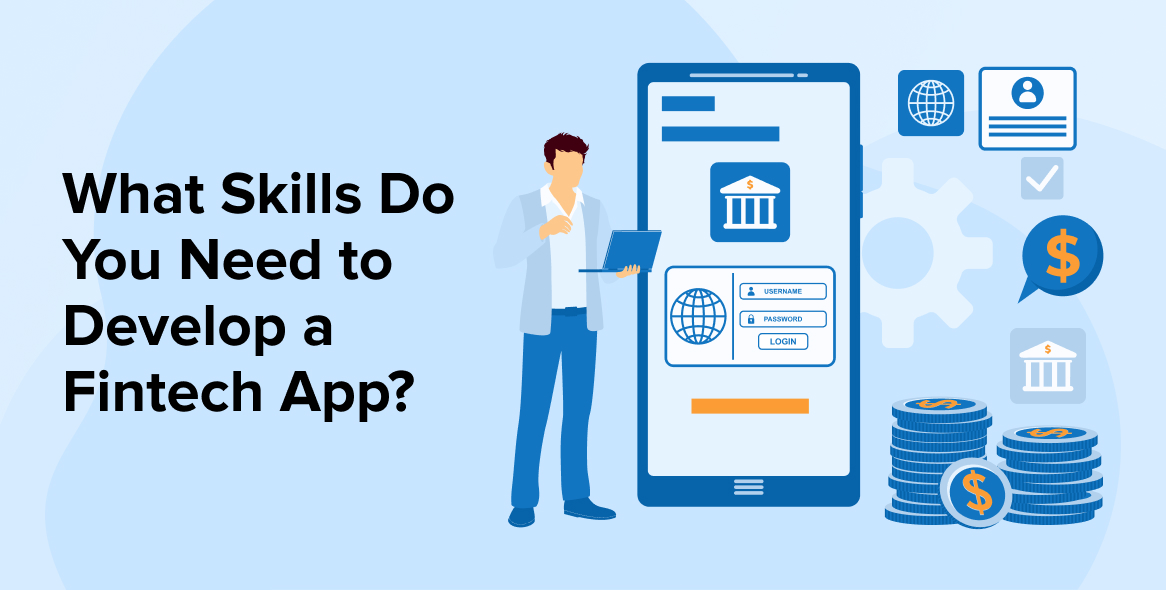
With time the financial industry has started adopting the latest technology stack to serve its clients. This has coined a new term called Fintech (financial technology). It means combining finance and technology together to create platforms from budgeting apps to transferring money. Fintech is a very powerful and fastest-growing area in the world. It offers convenience and excellent security approaches to traditional banking practices. It is completely replacing traditional financial methods of payment and monetary management. But to take advantage of fintech, we must first understand how to develop a fintech app.
Basically, a fintech app can be developed with the help of a financial software development company which is a very beneficial approach for businesses, users, and professional accountants. And this is because of its features that enable them to manage their bank account and financial transactions. To know more about fintech apps, their types, features, and development procedure, let’s go through this blog.
1. What is a Fintech App?
Fintech means financial technology that any web or mobile app offers to improve and automate the user’s financial services. Fintech helps business owners, companies, bankers, and other firms to manage their financial transactions by using special fintech apps. This concept has emerged in the 21st century and has started offering customer-oriented fintech mobile apps.
2. Types of Fintech Apps

When it comes to fintech, there are different types of popular fintech apps and they are –
2.1 Mobile Banking Applications
Since the emergence of fintech, one of the biggest transformations it has brought to financial institutions is by coming up with mobile banking apps. These applications have the capability to deal with all the primary banking functions like money transfer and savings. The mobile banking app has completely changed the working style of every financial institution. Now users don’t have to visit banks to perform any activity on their bank accounts, everything can be done through a fintech mobile app. Some of the most popular and secured mobile bank apps are Revolut, N26, and Monzo.
2.2 Budgeting Applications
Now, with the help of fintech, budgeting and financial planning, personal finance management, and investment management have become very easy. There are many investment apps in the market that people can use to save their money. These apps can also be connected to a user’s bank accounts. In this way, one can easily track and manage the budget. Some of the popular budgeting apps like Money Dashboard, Yolt, and Emma.
2.3 Insurance Applications
Insurtech is a new concept. It means insurance tech. With the help of insurance applications, users can buy insurance, calculate their premiums, apply for insurance claims, and do other activities. Some of the companies that offer insurtech solutions are Tractable, Zego, and Wrisk.
2.4 Stock Trading Applications
Stock trading has also become easier with the help of fintech solutions. Now we can get apps for stock trading and these apps help in buying and selling shares, tracking your portfolio, and researching investments. Some of the popular stock trading apps are IG, Etoro, and Plus500.
3. What are the Features a Fintech App Must Have?
Some of the most important features that every fintech application must have are –
3.1 Security
Any fintech solution must have all the required security measures to protect the user’s financial and personal information. And for this, fintech companies must use encryption, two-way authentication, blockchain, data obfuscation, and various other security measures useful for securing banking services.
3.2 Personalization
Personalization is something that grabs users’ attention and it makes them feel special. Therefore, any fintech application must offer tailor-made solutions to all its smartphone users. And in order to offer customized solutions, the cross-platform developers of the application must use different programming languages and technologies. AI is a technology that is used by fintech business analysts in many different ways. It helps the development team in analyzing the user’s patterns and offers relevant inputs about new policies, benefits, and updates. This is why the significant recommendation is helpful to the fintech startups or successful fintech companies in client retention.
3.3 Push Notifications
Push notifications enable the application users to know about new updates in the app, things they are missing out on, and more. Therefore, these types of notifications in fintech apps are very effective. They help in improving the communication between clients and bank officials. Besides this, the push notifications offer regular updates about new discounts and policies to the application users.
3.4 Support
The entire fintech industry uses highly confidential data and besides relying on two-factor authentication & third-party client services, fintech project owners also have to handle customer queries. Because of this reason, the traditional banks have to change their operational levels and have to train their employees to use financial apps and operate their technical aspects 24*7 for proper customer support.
4. Eight Steps to Build a Fintech App

Some of the major steps to building a fintech app are –
4.1 Choose a Fintech Niche
When any developer starts working on the fintech app development process, the first thing he has to do is determine is the niche of financial institutions. This means that before a programmer starts the fintech app development process he must figure out the kind of application the client wants and which area of fintech the client wishes to focus on. The reason behind it is that every business owner would want to have a unique application and won’t like to have the exact same app that is already available in the market.
4.2 Deal With Compliance
After understanding the niche of the fintech application, the next step is to deal with compliance. When the development team starts building mobile apps for a financial institute, they need to take care of all the Fintech legalities. For this, they must have the perfect protection systems like KYC(Know Your Customer) and AML(Anti Money Laundering) in the fintech applications. These systems help them in tracking compliance. Besides this, the fintech application for any business must also comply with the privacy laws like PIA, CCPA, LGPD, and GDPR. This helps in making sure that the financial data of financial app users are protected.
In addition to this, the choice of privacy for the paid apps completely depends on the region the app is going to be used. And this is because some countries have specific regulatory bodies while some don’t. For example, the USA doesn’t have a specific fintech regulator to comply with many federal laws.
4.3 Shape the Concept and Define Feature Set
The next step in creating a personal finance app for any business is to set the concept and features of the application. The features of a successful fintech app depend on its size and type. For this, the development team has to analyze the requirements of the mobile payments app to target the right audience. Some of the most common features that every fintech Android or iOS app must have are –
- Tracking of savings and budgets
- Push Notifications
- Highly Secure Login – Voice or Facial Recognition, Two-factor authentication, and Fingerprint
- Financial operations like checking balance, transferring money, and digital payments.
- AI-powered Chatbot or Virtual Assistant
- QR Code Scanning and Card Number Scanning
- Cashbacks, Deals, and Offers for the target audience
- Unconventional financial services such as donations and buying gift cards.
4.4 Create or Hire a Development Team
The most important thing to do while creating native apps for financial institutions is to hire the right team of fintech developers. The technical expertise required for fintech app development is –
- Web Developers
- UI Designers
- Quality Assurance Specialists
- Project Managers
- Business Analyst
- Android/iOS Developers
- Front-End and Back-End Developers
Basically, having a highly experienced team of software engineers ensures that the app will be of high quality. And hiring an experienced fintech app development team also helps in saving a lot of money and time in the longer run.
4.5 Choose the Right Managed Cloud Services Platforms
Web app developers use PaaS platforms like AWS Elastic Beanstalk to boost the development process. Besides accelerating the process, the PaaS platforms offer a lot of benefits like –
- With the help of PaaS platforms, integration of APIs(Application Programming Interface) is very easy and it also enables the developers to add services such as databases.
- A PaaS provider has the capability to manage various things like operating systems, networking, cloud infrastructure, runtime environment, and middleware.
4.6 Focus on UI/UX Design
When it comes to creating a fintech app, one of the most important things is having a good UI/UX design. UI/UX is a part of the app which enables the users to interact with the system. Therefore, the mobile application development team must ensure that the app is easy-to-use. The team must create various prototypes to analyze which design suits the application. Some of the great tips for a great fintech UI/UX design are –
- UI/UX design of the app must be straightforward.
- The features and functionalities of the app must be easy-to-use.
- Avoid adding needless features.
- App colors mustn’t be too bright or too dull.
- There mustn’t be any difficulty in finding options.
4.7 Develop An MVP
Testing the app idea before starting the lengthy development process is very important and for this, a concept called Minimum Viable Product (MVP) is used. It means a proof of concept that comes with features that can be tested before starting the banking app development. This process ensures that the app will run perfectly and bring great value to the user’s life. Basically, MVP is a process that enables the team to gather early feedback on the application so that the scope of improvement can be increased and risk factors can be decreased.
4.8 Refine and Support Your App
The last step in developing fintech apps is to offer after-deployment support. Fintech apps are generally prone to attacks and this means that keeping them up-to-date and giving constant support is very essential. Besides this, if there is a need to add any new feature to keep the users engaged, the team also does that under legal compliance.
5. Conclusion
As seen in this blog on how to develop a fintech app, fintech applications are helping the financial industry to evolve. These apps offer high-quality features like push notifications, personalization, and other online payment functionalities. And this is why the USA has observed 60% of usage growth in the year 2022. By seeing this level of acceptance, many businesses have started offering online payment systems and this has increased the demand for fintech app development experts who can follow the right steps to create a perfect fintech app.






Excellent article on creating a fintech app! I really appreciated that you covered selecting the appropriate technology stack and creating a secure fintech app. I appreciate these tips and insights!